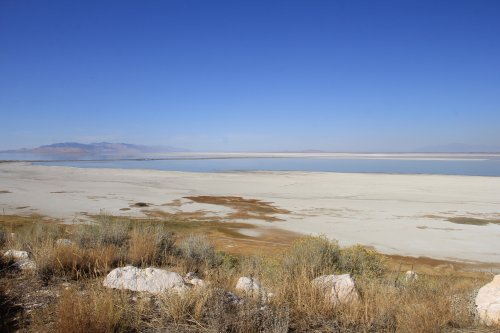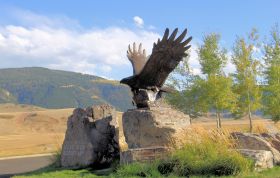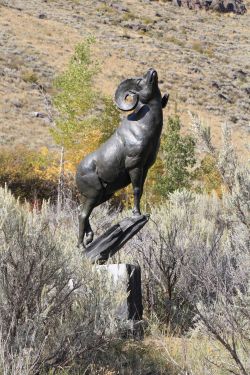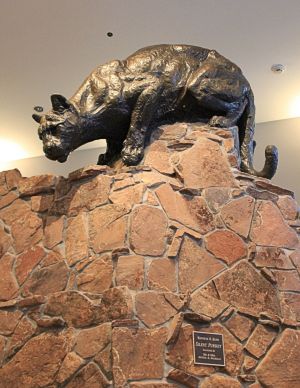27 September 2018, Dillon (Colorado) to Denver airport (Colorado): 106 miles
Tucking in
We’re flying out at 7.30pm this evening, so we decide to treat ourselves to a cooked breakfast at a little diner close to our accommodation. Not for the first time on this trip, I succumb to the temptation of biscuits and gravy. To most British ears this must sound like a dubious pleasure, and quite possibly no pleasure at all (on this point, have a look at this brilliant YouTube video of our fellow Brits getting their culinary knickers in a twist.) In my opinion however, biscuits and gravy really are rather good. The biscuits are thick, white and soft – like a savoury scone – and the gravy is a salty white sauce flavoured with pork sausage and black pepper. OK, it’s not cordon bleu, but for God’s sake we Brits invented Marmite and deep-fried Mars Bars so we’ve bugger-all to be smug about, have we?
Anyway, I’m tucking into my biscuits and gravy, a trickle of white sauce dribbling down my chin, and Mrs P is busily wrapping herself around several rashers of crispy bacon when, totally unexpectedly, a hummingbird appears outside the window. For the last three weeks we’ve been on the lookout for these magical little birds, and on our last day one turns up. Amazing.
Footsteps from the past
The plan is that on our way back to the airport we’ll call in at Dinosaur Ridge. This area is one of the world’s most famous dinosaur fossil localities where, in 1877, Oxford University-educated British emigrant Arthur Lakes found remnants of dinosaurs later known as stegosaurus, apatosaurus, diplodocus, and allosaurus. As a result, Dinosaur Ridge was to become one on the most important nineteenth century sites for dinosaur science in America. Half a century later some impressive footprints were found in the same area, and they remain some of the most easily recognisable signs that dinosaurs once walked the earth around these parts. Mrs P and I are not totally unfamiliar with dinosaur footprints – indeed many years ago in Utah I nearly broke an ankle by tripping up in a monstrous brontosaurus footprint – and we’re looking forward to seeing a few more.
We take a guided tour led by someone who really knows his stuff. Although there are a couple of people with us who are also familiar with the basics of dinosaurs and geology, some of the others are seriously, woefully ignorant. Rinker Buck, who wrote the book on the Oregon Trail that’s referred to earlier in this blog, says “Americans on summer vacation … are idiots, and haven’t read anything in years. Their every cranial neuron has been completely erased by watching Fox News.” Of course in many parts of the USA it’s illegal to teach kids about evolution, so maybe it’s expecting too much that the Americans in our party will be able to get their heads around stuff that happened tens of millions of years ago, and processes that took millions of years to complete. Whatever, at least the guys in our little group are trying … my God are they trying.

The fossil tracks themselves are pretty good. There are a number of footprints of iguanodon, a duck-billed plant-eating dinosaur that could walk either on its two hind legs or all four. They date from around 100 million years ago, when the animals were migrating along the shore of an ancient inland sea. The tracks have been shaded slightly to make them easier to see from a distance, but even without this the distinctive three-toed indentations in the rock would be easily visible. Intriguingly there are some smaller tracks running alongside one of the lines of larger footprints – this is thought to be the fossil record of a young iguanodon walking alongside its mother. There are also tracks of a much smaller, meat-eating dinosaur, reckoned to be about the size of an ostrich and therefore no threat to the iguanadons, adults of which were over 40 feet long and weighed more than three tons.


Other interesting features from the site include fossilised ripple marks from an ancient beach, isolated dinosaur bones including those of a stegosaurus, and the tracks of a prehistoric crocodile estimated to be about 40 feet long, which is twice the size of any croc alive today.
This could be the last time …
Dinosaur Ridge has been a fascinating place to end our trip, but now we have to get to the airport for this evening’s flight. We reflect on an outstanding trip: we’ve had brilliant weather, hot, dry and sunny. The wildlife watching has been superb, including brilliant views of grizzly bears, our first ever sightings of wolves and Californian condors, and more bison and pronghorn than you can shake a stick at. The scenery has been as majestic as always, and the geothermal landscapes have been spectacular. And there have been some special treats, including the Oregon ruts, a heritage railway and today’s dinosaur footprints. A great time has been had by all.
But at times it’s been tough too. We’ve been on more than a dozen road trips to the USA in the last 25 years, driving well over 50,000 miles, but this one feels the most demanding of them all, more traffic than ever, the rules of the road consistently baffling, the roadworks apparently endless, the signage more bizarre than any sane man can cope with.
A few days ago we were listening to Hippie Radio FM (no, I’m not making it up) when the Stones came on, Mick Jagger belting out The Last Time:
“Well this could be the last time
This could be the last time
Maybe the last time
I don’t know, oh no, oh no.”

As we reach the outskirts of Denver airport, we spot in the grass to our right the unmistakable humps and bumps of a prairie dog town. Several prairie dogs are sitting on their mounds, watching the world go by. Then one of them spots us. In a gesture typical of the species he rocks on to his back legs, throws his arms high in the air and his head far back, and utters a call that we can’t quite make out above the noise of the engine. It feels like a final salute: so long, he says, thanks for visiting us in our homeland, for coming here to get to know us all, for marvelling at our lives, and for appreciating our funny little ways. Farewell and God-speed.
Where the wild things are
The flight is OK, as flights go. Our broken suitcase has survived the trip, so we are spared the indignity of retrieving from the conveyor belt any spilled underwear and bars of soap we’ve liberated from our hotels along the way. We pick up the car from Long Stay and head for the M25.

The drive home is the worst ever. It should take no more than three hours, but it ends up being double that thanks to the combined impact of accidents, the weight of Friday afternoon traffic heading north out of London, and road ‘improvements’. Although we’re pleased to spot a couple of Red Kites flying over the M25, they are the only wildlife to be seen. Six hours at the wheel, and almost nothing worth seeing in all that time … oh, we’re so pleased to be back in the crazily crowded, monstrously polluted, concrete and asphalt jungle that we call home. Don’t you just love it?
I can’t bear the thought of never again getting up close and personal with the wildlife of north America. So I’m thinking, surely, if we plan it right and don’t over-stretch ourselves, we can manage just one more trip to Yellowstone, our spiritual home, our favourite place anywhere on the planet other than Orkney. Yellowstone, after all, is our sort of place, the place where the wild things are.






























